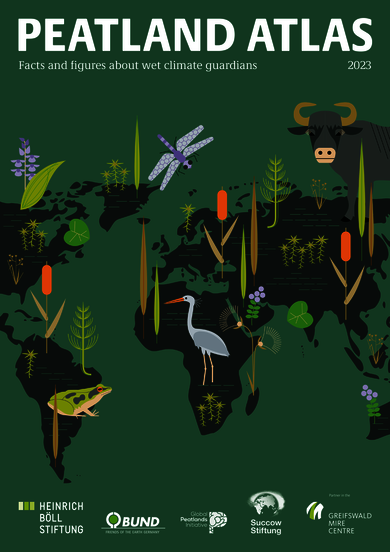Wildlife management
Content related to: Wildlife management
The Water Brothers

|
The Water Brothers, a Canadian, eco-adventure TV series is exploring our vital connection with water and examining the wetlands of Ontario. |
 |
|
The Breathing Lands highlights the peatlands of northern Ontario, emphasizing their vital roles in carbon storage and biodiversity while also acknowledging the threats posed to them by climate change and resource extraction. The episode showcases the work of several experts including Dr. Mike Waddington and Dr. Brian Branfireun who are researching the impact climate change will have on peatland fire behavior and peat carbon stocks. It also displays the work of Dr. Sarah Finkelstein, John Turner, and The Moose Cree First Nation who are working to map the carbon stocks and develop an Indigenous Protected and Conserved Area in the North French River watershed. |
 |
|
Paving over Paradise shifts the focus to Ontario's south and explores challenges around habitat loss due to increasing human development and invasive species. McMaster University researchers identify crucial Blanding turtle habitat, while Dr. Rebecca Rooney and Dr. Janice Gilbert combat phragmites, a highly invasive wetland plant. Organizations like ALUS and Ducks Unlimited Canada work to restore lost wetlands by compensating landowners for ecosystem services. |
Advances in Wetland Hydrology: The Canadian Contribution Over 75 Years
Wetland Knowledge Exchange October 2023 Newsletter
Applications to the BC First Nations Caribou Recovery Implementation Fund are now open!

Applications are now open for the First Nations Caribou Recovery Implementation Fund (FNCRIF). The FNCRIF was developed to reduce barriers for, and support participation by First Nations communities and organizations in recovery efforts for threated caribou herds in British Columbia.
Eligible projects include those which support and promote the recovery of caribou listed as “threatened” under the federal Species at Risk Act, and includes the following herds: Boreal, Southern Mountain-Northern Group, Southern Mountain – Central Group, and Southern Mountain – Southern Group. All First Nations communities with tradition territory within British Columbia, and First Nations organizations are eligible for funding.
For more information on this program, visit Fraser Basin Council - Caribou Recovery
*This news piece is being shared by the National Boreal Caribou Knowledge Consortium as the subject matter pertains to caribou and may be of interest to our audience.
Conservation Social Science: Understanding People, Conserving Biodiversity
Oil Sands Wetland Ecosystem Monitoring Program Indicators in Alberta, Canada: Transitioning from Pilot to Long-Term Monitoring
Video - Caribou Conservation Project
Sacred Science Video Series
Bringing together Indigenous knowledge and western science creates opportunities for new solutions to environmental challenges, including issues that are important to Indigenous People.
The Sacred Science video series, developed in collaboration with Indigenous communities in Alberta, Alberta Innovates and InnoTech Alberta, tells the stories of how these communities are leveraging these two knowledge systems to tackle complex conservation and land management challenges and to preserve their cultures.
These videos demonstrate successful collaboration between Indigenous communities and natural scientists that create meaningful impact and demonstrate our commitment to reconciliation, particularly in the natural sciences.
Peatland Atlas: Facts and Figures About Wet Climate Guardians

Although peatlands cover only 3% of the world's land, they store about twice as much carbon as in the biomass of all the world's forests combined. Thus, they are incredibly important especially for the climate and biodiversity. But worldwide more than 10 % of the 500 million hectares of peatlands are already drained, in parts of Central Europe well over 90 %. Every year, another 500,000 hectares of peatlands are destroyed. Drainage turns peatlands into climate killers, since - once drained - they release huge amounts of greenhouse gases - from permafrost in the north to palm oil plantations in Indonesia. With more than two billion tonnes of CO2, the draining of peatlands is responsible for about 4% of all human-made emissions globally. In addition, drainage is also disastrous for biodiversity. Unique habitats for specially adapted species are being lost.
This is outlined in the Peatland Atlas 2023 - Facts and figures on wet climate guardians.
It sheds light on the societal perception and history of peatlands, their importance for the global climate and as unique habitats for biodiversity and nature, and their destruction with local and global consequences. It also explains how we can protect peatlands and restore their functionality. It shows the potentials of wet peatlands for climate protection and opportunities for their wet use, called paludiculture, and how decision-makers and society can act now.
The Peatland Atlas is published by the Heinrich-Böll-Stiftung, the Michael Succow Stiftung, partner in the Greifswald Mire Centre, and BUND (Bund für Umwelt und Naturschutz Deutschland/Friends of the Earth Germany), with support of the Global Peatlands Initiative.
Here you may also find the German version, the Mooratlas.

